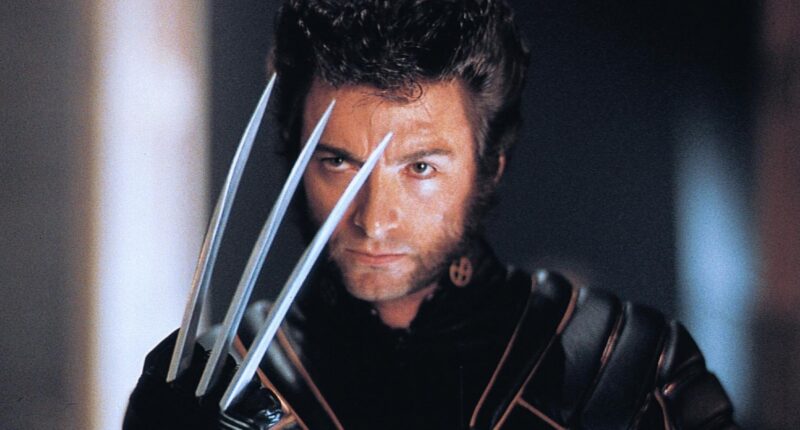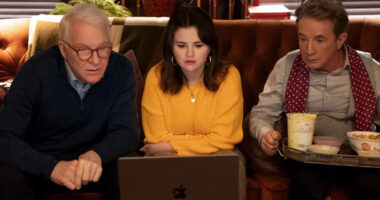Share this @internewscast.com
Boasting six claws, a regenerating ability, and a fierce berserker rage, Wolverine stands out as one of the most iconic superheroes. First brought to life by Len Wein and John Romita Sr. in 1974 through “The Incredible Hulk” #180-181, Wolverine eventually became a part of the X-Men — a powerful collective of mutant heroes dedicated to guarding a world that both fears and despises them. Over time, Wolverine has emerged as one of Marvel Comics’ most celebrated and easily recognizable heroes.
The character of Wolverine transitioned from comic book pages to the big screen via 20th Century Fox’s 2000 action flick “X-Men,” marking the initial cinematic adaptation of Marvel’s beloved mutants. Portrayed by Hugh Jackman, Wolverine (or Logan) was brought to life as a lone wolf with a tough exterior, complemented by a heart of gold beneath his adamantium bones. Since his debut, Jackman reprised this role across nine more films over a span of 25 years, setting a record for one of the longest portrayals of a Marvel superhero by a single actor. Navigating the complex X-Men movie timeline can be daunting, but if you’re unsure where to begin, rest assured. All 10 films are available on Disney+, and here’s the recommended sequence to watch Wolverine’s journey unfold:
- “X-Men” (2000)
- “X2” (2003)
- “X-Men: The Last Stand” (2006)
- “X-Men Origins: Wolverine” (2009)
- “X-Men: First Class” (2011)
- “The Wolverine” (2013)
- “X-Men: Days of Future Past” (2014)
- “X-Men: Apocalypse” (2016)
- “Logan” (2017)
- “Deadpool & Wolverine” (2025)
Will Hugh Jackman prove Deadpool’s prediction correct that “he’ll do this till he’s 90”? Only time will tell. Meanwhile, let’s dive into why this sequence offers the best experience for viewing Wolverine’s cinematic adventures.
Why is this the correct order to watch the Wolverine movies?
In the way that a superhero comic book series introduces its characters, conflicts, and themes in its inaugural issue, the 2000 “X-Men” film lays the groundwork for the entire series that follows. In addition to introducing critical characters such as the telepathic Professor Charles Xavier (Patrick Stewart) and the metal-controlling Magneto (Ian McKellen), the film also sets up the Xavier Institute for Gifted Youngsters — a major setting for most films — and the ongoing conflict between the X-Men and the Brotherhood of Mutants over humanity’s future.
“X-Men” serves as the ideal opening for Wolverine’s story. When Wolverine is first encountered, he’s an amnesiac piecing together fragments of his tumultuous past, with the full reveal of his identity unfolding through multiple stories. Although “X-Men Origins: Wolverine” might seem like an appropriate starting point — given its title — doing so would spoil the unfolding mystery too soon. Plus, let’s face it, new viewers should steer clear of one of the franchise’s weakest entries.
X-Men
Experiencing Wolverine’s evolution from a solitary fighter to a hero of global significance starts best at the original source. In “X-Men,” mutants are portrayed as humanity’s next evolutionary phase, yet society fears and alienates them. We are introduced to Logan as a gruff, secretive cage fighter who befriends Rogue (Anna Paquin), a young mutant runaway with the ability to absorb others’ life forces. When the extremist Magneto captures Rogue as part of his mission to turn world leaders into mutants, Logan joins the X-Men — a group striving for peaceful coexistence between mutants and humans — to rescue her.
Directed by Bryan Singer, “X-Men” brought superhero movies into the 21st century, ushering in a new era for Hollywood blockbusters. Criticized by comic book fans for its changes to the source material — the X-Men now wear black leather uniforms instead of more colorful costumes — this Saturn Award-winning film holds its own against the dozens of superhero movies made in its wake. “X-Men” firmly establishes the themes and character arcs that continue across its many follow-ups, such as the love triangle between Wolverine, Jean Grey (Famke Janssen), and Cyclops (James Marsden), and using mutants as a metaphor for marginalized groups experiencing discrimination.
X2
“X-Men” introduces Wolverine as a man who has no memory of his past, with only a few clues about how and why he acquired his adamantium claws and skeleton. Bryan Singer’s 2003 sequel “X2” warns Logan that some mysteries are perhaps better left unsolved. After a teleporting mutant named Nightcrawler (Alan Cumming) attacks the White House, the president authorizes military scientist William Stryker (Brian Cox) to invade the Xavier Institute.
Wolverine violently dispatches the soldiers, saving Rogue and her boyfriend Bobby (Shawn Ashmore), but Stryker captures several students as well as Professor X. The X-Men will need to join forces with Magneto and the shapeshifting Mystique (Rebecca Romijn) to save them, but dark secrets lurk under Stryker’s base at Alkali Lake.
Praised by critics and fans upon release, “X2” is considered to be one of the rare sequels that’s equal to, or better than, its predecessor, and today it is regarded as one of the standout installments in the entire “X-Men” film franchise. Featuring memorable sequences such as Magneto’s ingenious escape from his plastic prison and Bobby reluctantly “coming out” as a mutant to his human parents, “X2” embodies everything that makes the “X-Men” movies successful. Here, Wolverine fully unleashes his berserker rage and faces a devastating loss, revealing the full power of Hugh Jackman’s physical and emotional range.
X-Men: The Last Stand
The original X-Men trilogy comes to an explosive — and controversial — end in 2006’s “X-Men: The Last Stand.” Jean Grey returns after seemingly sacrificing herself to save the X-Men at the end of “X2,” but her resurrection has unleashed a dark, powerful alternate personality: the Phoenix. As Wolverine tries to save the woman he loves, Magneto gathers an army to attack Alcatraz and slay a mutant child being used to develop a “cure” for mutation. Battle lines are drawn as the X-Men prepare for their “last stand.”
Following the departure of Bryan Singer, who had directed the previous two films, Brett Ratner helmed “X-Men: The Last Stand” to decidedly mixed results. The film suffers as a poor, rushed adaptation of the classic “Dark Phoenix Saga” comic book storyline, featuring a relentless barrage of gratuitous cameos and a script that leaves several major characters either dead or without their mutant powers.
Hugh Jackman and Famke Janssen wring some heat and pathos out of their doomed romance, however, with Wolverine’s love for Jean Grey haunting him in subsequent films. With “The Last Stand” being in many ways a narrative dead end for the franchise, the only way for Wolverine to move forward was to go back in time.
X-Men Origins: Wolverine
The first of three Wolverine solo films, 2009’s “X-Men Origins: Wolverine” reveals Logan’s violent past as a member of Team X under the villainous thumb of William Stryker (now played by Danny Huston). “Origins” begins in 1845, when the young James Howlett (Troye Sivan) sprouts bone claws from his knuckles and kills his biological father. Running away with his mutant half-brother Victor (played as an adult by Liev Schreiber), James takes the name “Logan” and fights in several wars throughout the centuries. Eventually tiring of violence, Logan attempts to live a peaceful life with his girlfriend, Kayla Silverfox (Lynn Collins), but Stryker won’t let go of him so easily.
Unfortunately for audiences eager to know more about Wolverine, one of his most essential films is also one of the worst. “X-Men Origins: Wolverine” suffers from a bland, cliché-ridden script and a risible climax that credits Wolverine with the Three Mile Island nuclear disaster. The film is not without its bright spots, such as the casting of Ryan Reynolds as the mouthy, sword-swinging mercenary Wade Wilson, though fans would be denied a true team-up until 2024’s “Deadpool and Wolverine.”
X-Men: First Class
“X-Men: First Class” rejuvenated the ailing franchise by turning back the clock to 1962, revealing how Professor X and Magneto formed the original X-Men team during the existential threat of the Cuban Missile Crisis. Now played by James McAvoy and Michael Fassbender (perhaps the only two actors capable of recreating Stewart and McKellen’s onscreen chemistry), Oxford scholar Xavier and Nazi-hunter Magneto are drawn together to stop the evil Sebastian Shaw (Kevin Bacon) and his Hellfire Club from triggering a nuclear apocalypse.
Gathering together a team of young mutants including Mystique (Jennifer Lawrence) and Beast (Nicholas Hoult), Xavier and Magneto develop a powerful bond that is inevitably torn apart by their opposing worldviews — and mutantkind will never be the same.
Unlike the rest of the films mentioned so far, Hugh Jackman’s Wolverine has only a brief, but very memorable, cameo in 2011’s “X-Men: First Class.” The scene humorously defies the audience’s expectation for a dramatic first meeting between Wolverine and the future leaders of the X-Men and the Brotherhood, and it receives an equally surprising payoff in “X-Men: Days of Future Past.”
The Wolverine
After two prequels set decades in the past, 2013’s “The Wolverine” returns to the present and finds Logan alone and adrift. Following the events of “X-Men: The Last Stand,” Logan is haunted by visions of Jean Grey. Summoned to Japan, he reunites with Yashida (Haruhiko Yamanouchi), an old friend whom Logan saved from the bombing of Nagasaki in World War II.
Yashida offers Logan a “cure” for his death-defying healing factor, but he and the toxic mutant Viper (Svetlana Khodchenkova) have a sinister ulterior motive. With the help of the spirited assassin Yukio (Rila Fukushima), Wolverine must defeat Viper if he’s to save the next love of his life — Yashida’s beautiful granddaughter, Mariko (Tao Okamoto).
Directed by James Mangold, “The Wolverine” is a strong and vibrant adaptation of the classic 1982 “Wolverine” comic book miniseries by Chris Claremont and Frank Miller. The second film in the “Wolverine” trilogy is a surprisingly thoughtful meditation on time and grief, as Logan struggles with outliving his friends and lovers, but still finds himself capable of opening his heart to Yukio and Mariko. Transporting Logan to Japan also gives “The Wolverine” a new level of creative freedom, as our hero uses his adamantium claws to slice and dice ninjas, bullet train assassins, and even the man in the monstrous mecha suit called the Silver Samurai. And be sure to sit through the end credits — an after-credits scene sets up Logan’s critical role in our next film.
X-Men: Days of Future Past
The first X-Men film to be nominated for an Academy Award, 2014’s “X-Men: Days of Future Past” is an exciting and triumphant time travel epic. Based on the classic 1981 “Uncanny X-Men” story arc of the same name by Chris Claremont and John Byrne, “Days of Future Past” begins in a dystopian future where most mutants have been hunted down and killed by robots called Sentinels.
The surviving X-Men, including Professor X and Magneto (Patrick Stewart and Ian McKellen, returning to the roles they originated), send Wolverine’s consciousness back in time into his body in 1973. His mission? Reunite the young Xavier and Magneto (James McAvoy and Michael Fassbender, also reprising their roles) and stop Mystique from carrying out a political assassination, hopefully changing the course of history.
Featuring the return of several major characters as well as “X-Men” and “X2” director Bryan Singer, “X-Men: Days of Future Past” thankfully doesn’t coast on nostalgia. Ambitious and action-packed, it includes jaw-dropping spectacles like the super-fast Quicksilver (Evan Peters) running circles around security guards while listening to Jim Croce’s “Time in a Bottle.” Wolverine serves as a sturdy bridge between the past and future timelines; he is especially moving in his scenes with the younger, more cynical Xavier who needs to believe in hope again. “X-Men: Days of Future Past” has two available versions to watch: the theatrical cut, and the expanded “Rogue Cut” which restores Anna Paquin’s deleted scenes as Rogue and helps bring her relationship with Logan full circle.
X-Men: Apocalypse
The sequel to “X-Men: Days of Future Past,” 2016’s “X-Men: Apocalypse” follows the X-Men of the 1980s, introducing the teenage incarnations of Jean Grey (Sophie Turner), Cyclops (Tye Sheridan), Storm (Alexandra Shipp), and Nightcrawler (Kodi Smit-McPhee). In Egypt, the ancient mutant Apocalypse (Oscar Isaac) awakens, recruiting Magneto for his four deadly Horsemen and abducting Professor Xavier to serve as his new host body. But before rescuing the Professor, the mutants free their allies held captive in William Stryker’s (Josh Helman) base — including the man called Weapon X.
This is another reduced role for Wolverine, albeit much more substantial (and violent) than his “X-Men: First Class” cameo. As part of the new reality established via time travel in “Days of Future Past,” Wolverine is a prisoner of the Weapon X program, and his escape is notably different than the one depicted in “X-Men Origins: Wolverine.” (See what we mean about the X-Men timeline being complicated?) In a key scene, Jean Grey uses her telepathy to partially restore the berserk Logan’s humanity, strengthening the empathetic connection between the two that has prevailed throughout the series.
Logan
All stories must come to an end, and Wolverine meets his final fate in 2017’s powerful and elegiac “Logan.” The last film in the “Wolverine” trilogy is also the first to be rated R, with star Hugh Jackman and returning director James Mangold stripping the superhero myth bare to show the wounded man underneath it all.
In a grim and barren future, the X-Men are dead, no new mutants have been born in years, and Wolverine’s healing factor is finally slowing down. Living in anonymity with the elderly, dementia-stricken Professor X (a heartbreakingly excellent Patrick Stewart), Logan is pulled out of hiding to protect Laura (Dafne Keen), a young mutant girl created from Logan’s DNA.
In a major shift from the previous films, “Logan” is ultra-violent, harsh, and unsparing, but also incredibly tender and profound. “Logan” is regarded as one of the best superhero films ever made, and it has the honor of being the first comic book film to be nominated for the Academy Award for best adapted screenplay.
Deadpool and Wolverine
So, wait, if “Logan” is the last Wolverine film, then who is the clawed mutant in “Deadpool and Wolverine”? Good question. 2024’s “Deadpool and Wolverine” is the third feature film to star Deadpool, the metafictional Merc with a Mouth first played by Ryan Reynolds all the way back in “X-Men Origins: Wolverine.” Hopping across the multiverse, Deadpool searches for a Wolverine variant who can help save his deteriorating world.
He inevitably ends up with the “worst” Wolverine (still gamely played by Jackman), whose abandonment of the X-Men in his alternate timeline led to their deaths. Banished to the Void at the end of time, Deadpool and Wolverine must join forces to save the multiverse from the despotic Cassandra Nova (Emma Corrin). That is, if the two unkillable heroes don’t somehow kill each other first.
Hugh Jackman makes a surprise return to his career-defining role in the wickedly funny and brutally violent “Deadpool and Wolverine.” His chemistry with Reynolds is electric, and the film makes fanboy dreams come true by — finally — making Wolverine suit up in his classic yellow and blue costume. If “Deadpool and Wolverine” proves to be Jackman’s final outing as Logan, he goes out with a bang — or rather, a hack and a slash.
Is there another way to watch the Wolverine movies?
If you’ve already watched the Wolverine and X-Men movies as they were released, but want to examine this long-running franchise from a bold new angle, they also can be watched in chronological order. By starting the film series with “X-Men Origins: Wolverine” and ending with “Logan,” you can watch the entire centuries-sweeping saga unfold from Wolverine’s childhood in the 1840s to his final adventure in the 21st century. For those interested in experiencing Logan’s life story from the very beginning, watch the films in this order:
- “X-Men Origins: Wolverine” (2009)
- “X-Men: First Class” (2011)
- “X-Men” (2000)
- “X2” (2003)
- “X-Men: The Last Stand” (2006)
- “The Wolverine” (2013)
- “X-Men: Days of Future Past” (2014) (start of the new timeline)
- “X-Men: Apocalypse” (2016)
- “Logan” (2017)
- “Deadpool and Wolverine” (2025)
Unfortunately, watching the films in strict chronological order won’t be a perfectly linear experience, given the films’ use of flashbacks, montages, and time travel. It simply isn’t realistic to expect viewers to pause and restart “X-Men: Days of Future Past” whenever it skips between 1973 and 2023, for example. Including “Deadpool and Wolverine” as an epilogue gives the chronological order a unique symmetry, as the Wolverine films are bookended with fateful encounters between Hugh Jackman’s beloved X-Man and Ryan Reynolds’ foul-mouthed assassin.









